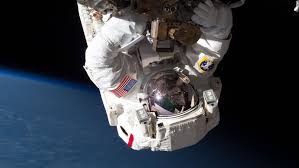Six of the astronauts experienced stagnant or reverse blood flow, one had a blood clot and another was found to have a potential partial blood clot.
The study, which involved nine men and two women with an average age of 46, published Wednesday in the journal JAMA Network Open. The identities of the astronauts were not included in the study.
This is the first time researchers have observed these conditions in astronauts and the implications of their discovery could impact future long-term spaceflight, such as a mission to Mars.
After more than 50 years of human spaceflight, researchers know some of the risks posed to the human body by being in zero gravity. Space motion sickness happens in the first 48 hours, creating a loss of appetite, dizziness and vomiting.
Over time, astronauts staying for six months on the station can experience the weakening and loss of bone and atrophying muscles. Astronauts also experience blood volume loss, weakened immune systems and cardiovascular deconditioning, since floating takes little effort and the heart doesn't have to work as hard to pump blood. Scott Kelly and other astronauts in their late 40s and 50s have also complained about their vision being slightly altered. Some of them have required glasses in flight.
And the Twins Study, comparing changes in astronaut Scott Kelly during his yearlong spaceflight mission while his twin, Mark, was on Earth revealed numerous other changes affecting gene expression and the microbiome.
The weightless environment of zero gravity causes a fluid shift in the body toward the head, the opposite of what we experience standing on Earth. On Earth, humans spend about two-thirds of the day in an upright position and about a third laying down at night. This causes a daily fluid shift that varies based on our position.
But for astronauts, the fluid shift is sustained for long periods of time. It causes puffiness in the face, "bird leg" syndrome where the legs lose volume, and decreases plasma volume while increasing stroke volume -- the volume of blood pumped per beat.
"A recently identified medical issue with long duration spaceflight on the International Space Station is a constellation of neuro-ocular issues that we've coined SANS -- Spaceflight Associated Neuro-ocular Syndrome," said Michael Stenger, study author and director of NASA's Johnson Space Center Cardiovascular and Vision Laboratory.
"Approximately 10 years ago, we noticed that astronauts were developing optic disc edema, globe flattening, choroidal folds and permanent refractive error changes. The purpose of our experiment was to quantify the headward fluid shift in all astronauts by examining arterial and venous structure and flow characteristics in the head and neck (as well as several other parameters) and determining the relationship between these parameters and ocular structural and functional changes."
The researchers wanted to assess how this fluid shift affected the left jugular vein. This vein carries deoxygenated blood from the head and neck to the vena cava, the largest vein in the upper body.
The researchers disclosed that one limitation of the study is that they did not image the right jugular vein, but it has been analyzed in previous spaceflight studies and there was no sign of stagnation or clotting.
The astronauts provided blood flow measurements before and after spaceflight while seated, laying down and angled at a 15-degree downward head-tilt.
Measurements during the flight were taken on days 50 and 150 of the mission.
The astronaut who developed a blood clot was treated with anticoagulants for the rest of the spaceflight and did not participate in the study past day 50.
The observation that blood was clotting in otherwise healthy astronauts, both male and female, due to weightlessness was a surprise to researchers, who are concerned due to the other issues blood clots can cause.
"Blood clots that are newly formed and small are easily filtered out of the circulation in the lungs," Stenger said. "If one were to grow excessively large and solidify, then one would be at risk of a pulmonary embolism. This formation of clots is the primary concern related to flow stasis."
The idea of reverse blood flow requires more scrutiny.
"Reverse flow is really interesting, and we're uncertain if it harmful," Stenger said. "Reverse flow in the jugular vein could be completely harmless as the blood is simply leaving the head via one of the other venous pathways. However, reverse flow implies altered venous pressure dynamics, which could impact the ability of the brain to drain cerebral spinal fluid and possibly increase pressure in the brain. This is something we're continuing to investigate."
A possible way to reverse the head-ward fluid shift is to apply lower body negative pressure.
The Russian side of the space station includes a Chibis suit that was used to test this method. The suit basically acts as vacuum-sealed pants, according to the study authors.
"It encompasses the lower limbs in a hard enclosure that is sealed at the waist and connected to a vacuum pump to decrease the pressure in the chamber around the lower limbs to subatmospheric pressure," the authors wrote.
"Lower body negative pressure sequesters fluid volume, mainly venous blood, in the lower extremities and is used by cosmonauts on the ISS as a countermeasure for postflight orthostatic intolerance."
Other possible ways to shift fluid from the upper body could include thigh cuffs, resistance breathing devices and acceleration via cetrifugation, Stenger said.
Stenger pointed out that research should be fast-tracked to better understand the issue, as well as considering the limits on medical and research capabilities on vehicles used in future exploration missions.
"As potentially scary as this may sound, this novel and interesting finding isn't terribly concerning," Stenger said. "The reality is that this has probably been happening since we started flying in space, we just never looked before. This gives us the opportunity to now conduct further research to determine what is causing this before speculating too much on potential consequences.'
Of the 17 sessions with the Chibis suit during flight, 10 were associated with improved blood flow, two actually showed worsened flow and five did not cause any changes, according to the study. During sessions when blood flow improved, three astronauts actually went from stagnant or reverse blood flow to regular.
"This study underscores the need to monitor vascular changes in astronauts," said Christopher Mason, one of the Twins Study authors and an associate professor of physiology and biophysics at Weill Cornell Medicine. Mason was not affiliated with this study. "Stagnant and retrograde blood flow can lead to complications, such as thrombosis [blood clotting], but fortunately can be tracked and treated. Also, just like taking a long flight, the risk of this would almost certainly resolve upon landing back on Earth."
More about:
















































